Walkease
Early Intervention Hoof Treatment
Walkease
Early Intervention Hoof Treatment
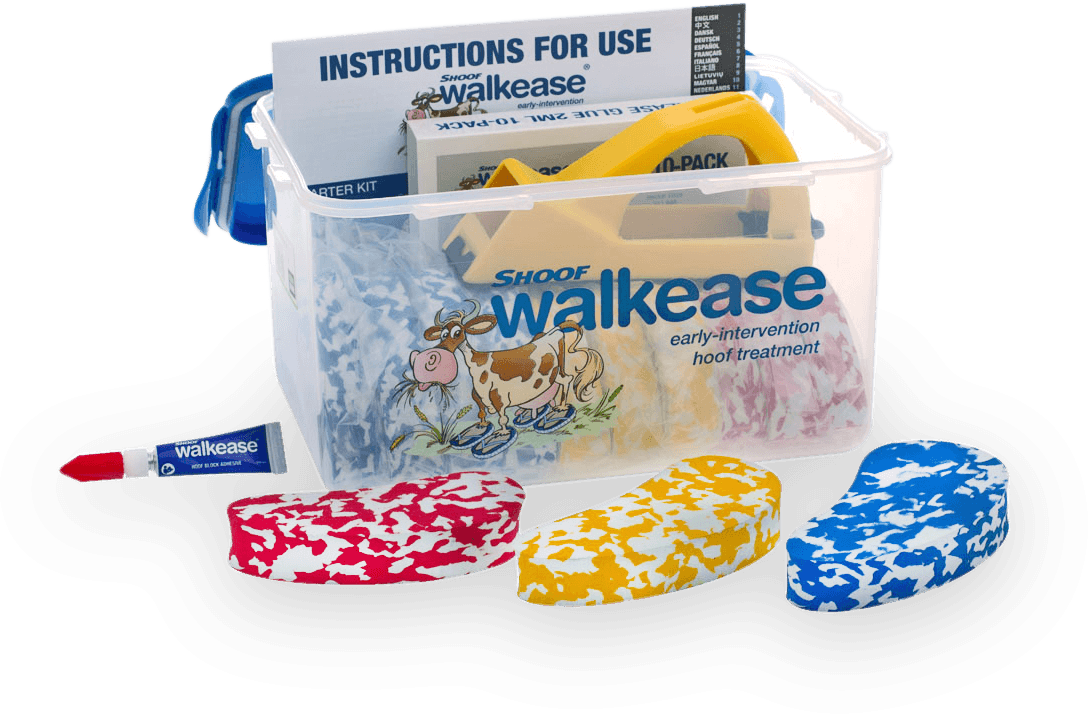
Demonstration
The Walkease hoof care system is easy to apply. Learn more about how to apply the Walkease block correctly to your cow’s hoof.
First prepare the hoof
Careful hoof preparation is key to successful Walkease application.
Then choose a block size
Selecting the correct Walkease block size is important.
Finally glue block in place
The Walkease glue is integral to hoof block application.
Step-by-Step Instructions
Below are more detailed instructions for applying Walkease. For any fitting issues, visit the FAQs page.
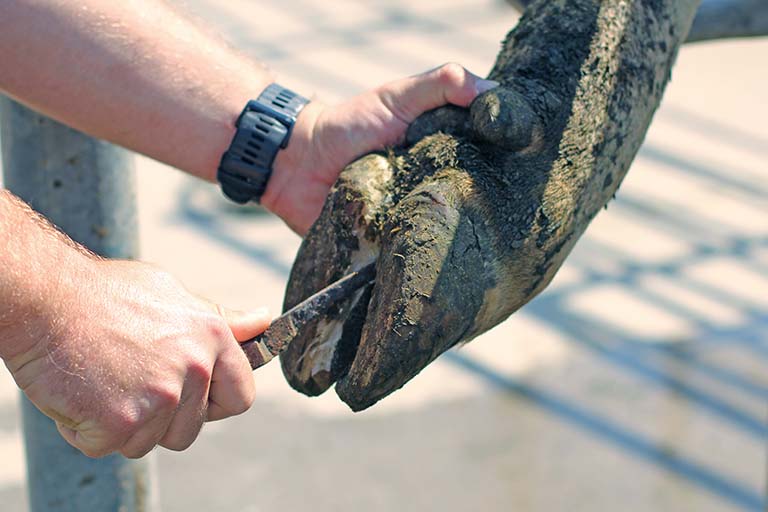
Treat the injured claw
Treat the injured claw first before moving onto the adjacent claw. Use a grinder or a hoof knife to leave the healthy claw as flat as possible. Ensure all debris is removed and the fresh horn exposed.
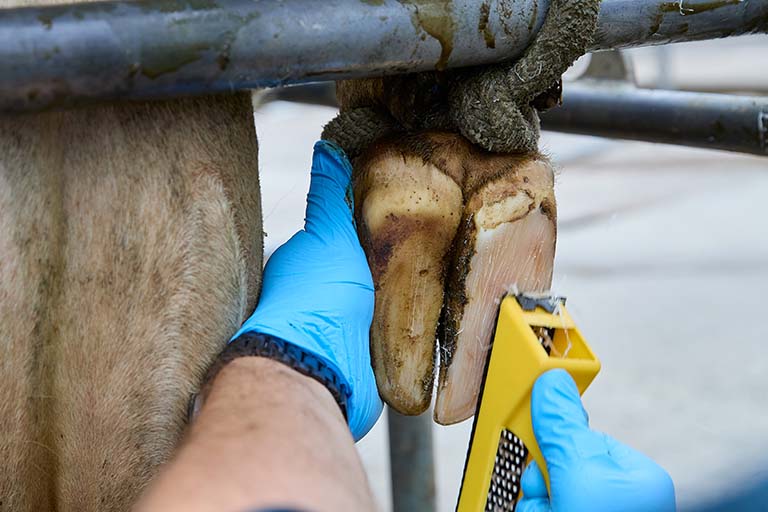
Use the Walkease rasp
Always use the Walkease rasp to finish preparing the adjacent hoof surface. Expose fresh horn to provide a clean, flat surface for maximum contact and block adhesion. The rasp must be kept clean and uncontaminated when not in use.
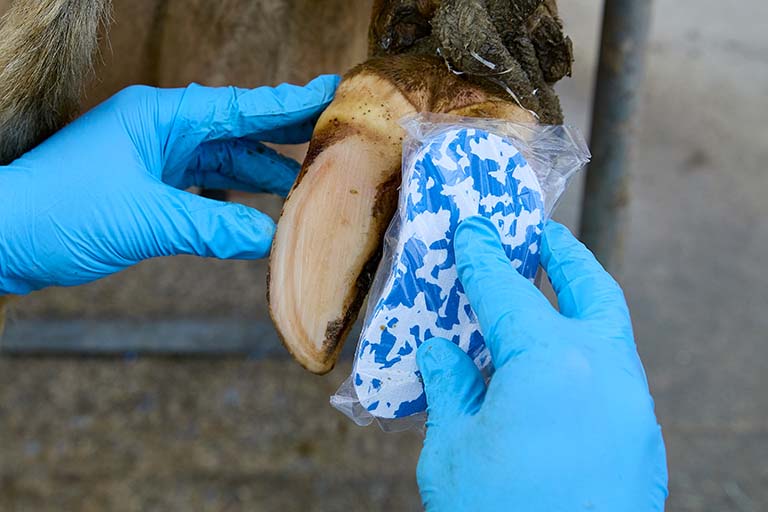
Check the block is the correct size
Compare the size and shape of your chosen block before removing its plastic wrapper. Your chosen block must support the hoof wall without any large overlap. Blocks can be trimmed if required. Walkease blocks can be used for left or right hooves – simply turn the block over.
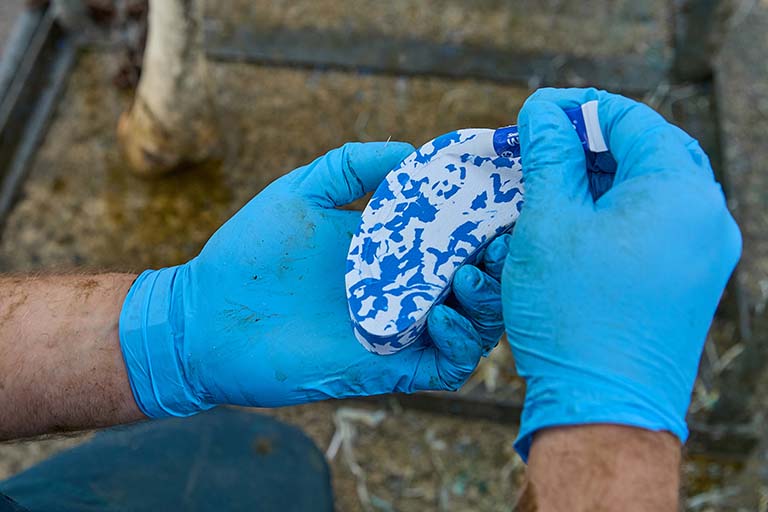
Dispense full tube of single-use glue
Always wear gloves when handling Walkease glue. Use the full contents of the 2ml single-use tube to secure the block. Regular, slim lines of glue are better than thick, irregular distribution across the block.
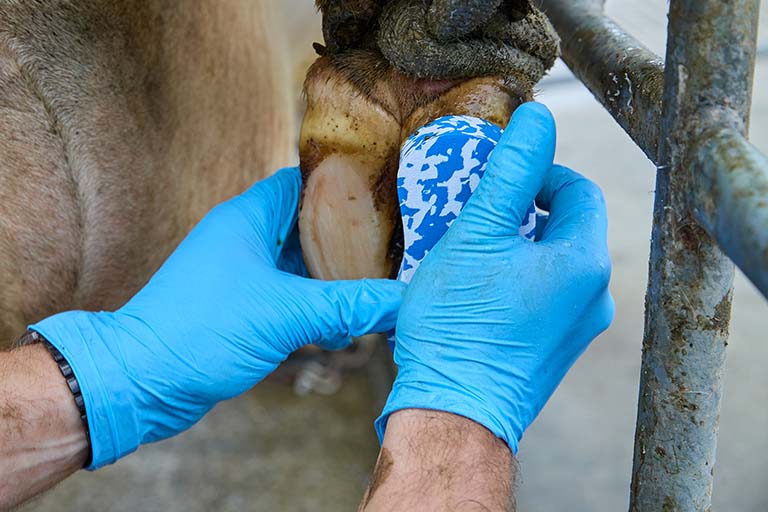
Press the block firmly
Press the block firmly onto the healthy claw, overlapping the hoof wall. After about 10 seconds of steady, even pressure you will feel the block ‘grip’.
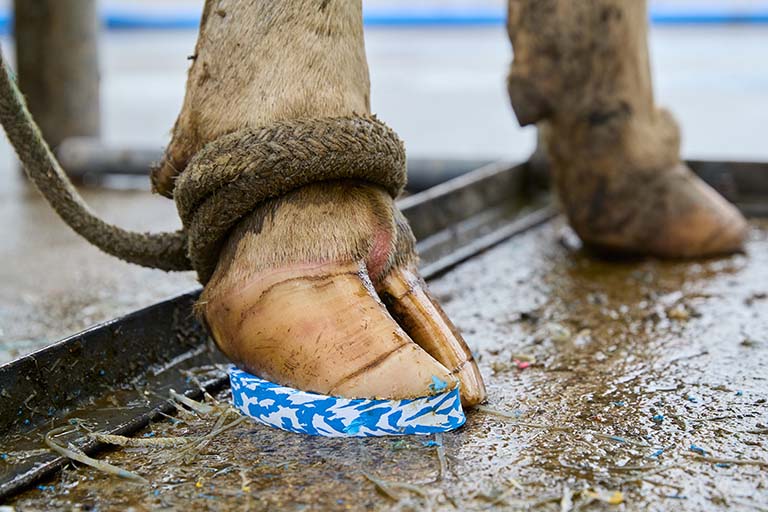
Drop the cow's leg immediately
It is important to immediately lower the hoof once the glue grips. The weight of the cow will increase the contact between the block and the hoof generating a stronger bond. In cold conditions, allow the cow to stand for longer, before release. The Walkease block will only attach properly when weight is applied before the glue has completely cured.
Download Walkease Instructions
Select your language. For more information, check out the FAQs page.
Walkease Hoof Blocks
Walkease blocks come in four different sizes from x-small to large.
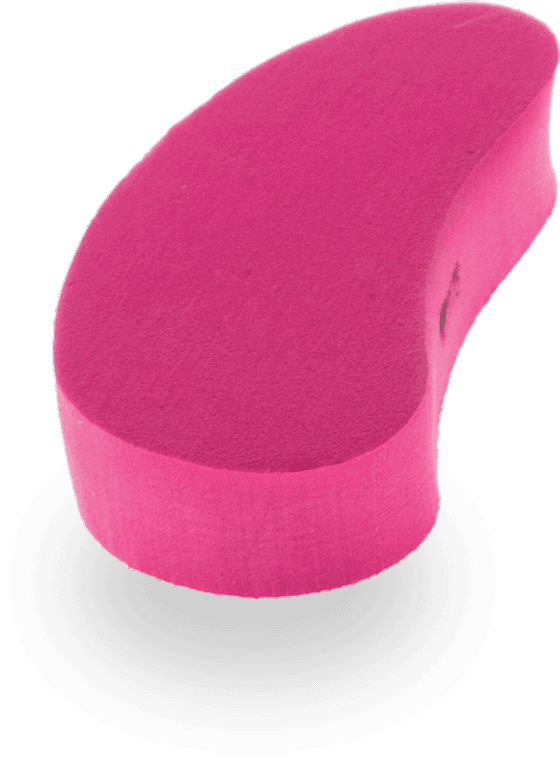
X-Small Block
100mm (L) x 43mm (W) x 20mm (D)
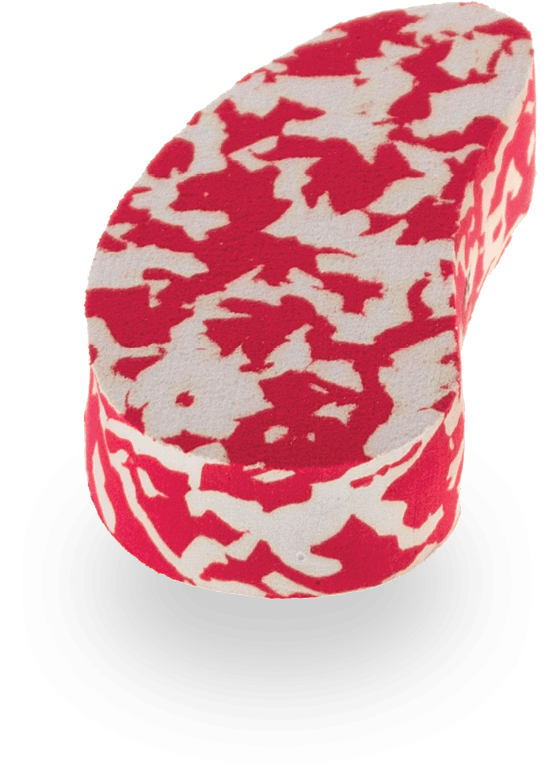
Small Block
107mm (L) x 45mm (W) x 20mm (D)
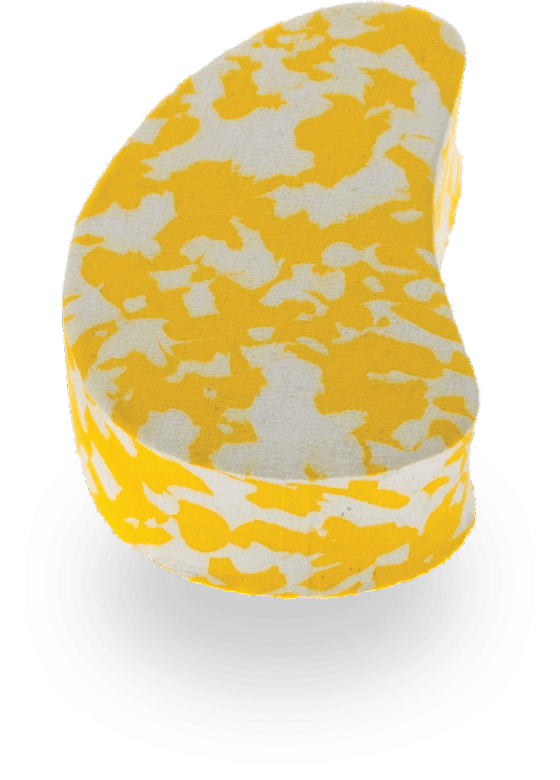
Medium Block
118mm (H) x 50mm (W) x 20mm (D)
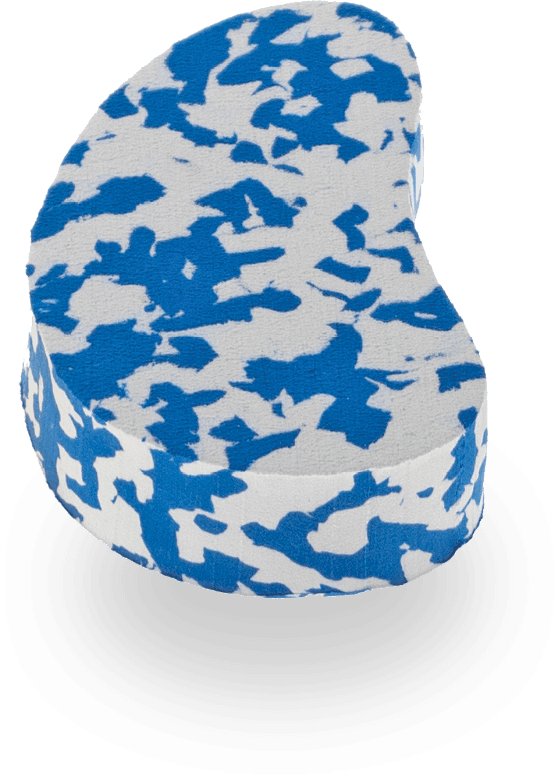
Large Block
122mm (L) x 60mm (W) x 20mm (D)
The ‘Wedgie’
The Wedgie is designed like a wedge, taller at one end than the other. It is designed to enhance correct hoof angle and improve locomotion score following a period of lameness.
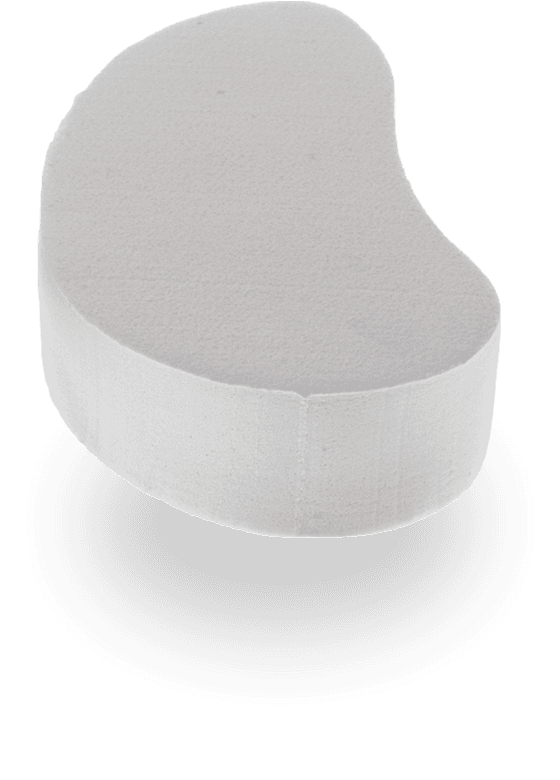
Wedgie Block
122mm (L) x 60mm (W) x 25mm (D) end 1 and 15mm (D) end 2

Walkease Complete Starter Kit
The Walkease Complete Starter Kit contains:
- 10 x mixed blocks or your chosen size (see below)
- 10 x 2ml tubes of Walkease Glue
- 1 x Walkease Rasp
- an instruction booklet in 18 languages
- a handy plastic container to store your Walkease
Walkease Starter Kit small blocks (red)
Shoof code 212 090
Walkease Starter Kit medium blocks (yellow)
Shoof code 212 091
Walkease Starter Kit large blocks (blue)
Shoof code 212 094
Walkease Starter Kit mixed sizes (3 x small, 3 x medium, 4 x large)
Shoof code 212 102
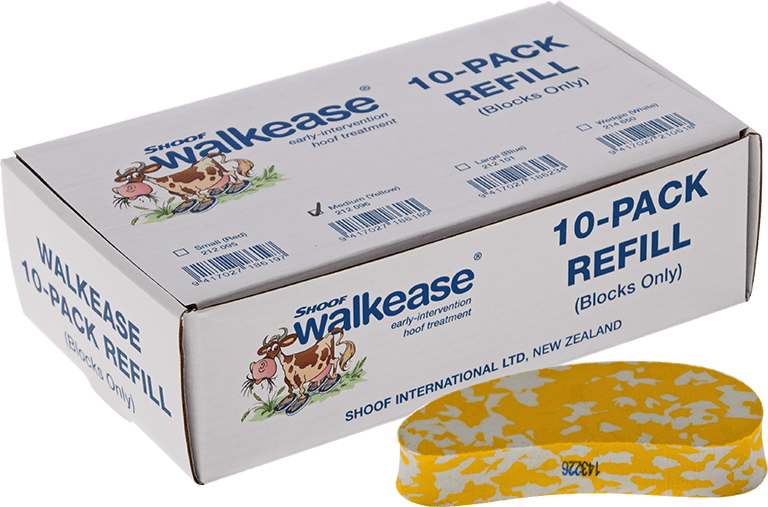
Walkease 10pk (blocks only)
Walkease blocks only x-small (pink)
Shoof code 217 464
Walkease blocks only small (red)
Shoof code 212 095
Walkease blocks only medium (yellow)
Shoof code 212 096
Walkease blocks only large (blue)
Shoof code 212 101
Walkease blocks only wedgies (white)
Shoof code 214 650
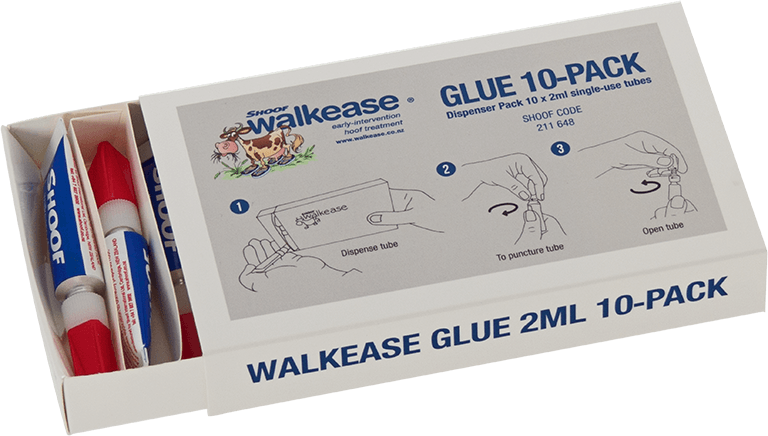
Walkease Glue 10-Tube Pack (2ml per tube)
Dispenser box containing a 10-tube pack of 2ml Walkease glue
Shoof code 211 648
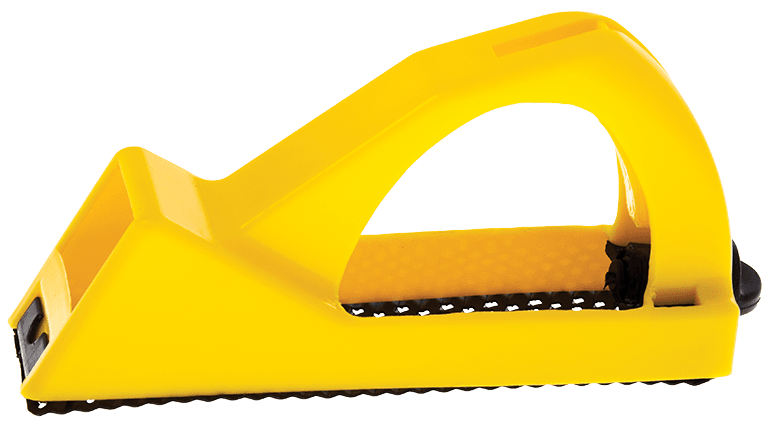
Walkease Rasp
Walkease rasp
Shoof code 223 467
Hoof Preparation
Can I use a hoof rasp?
A ‘Walkease’ rasp is supplied in the Starter Kit so the user will have a tool for final correct preparation of the hoof before application of the Walkease block. The purpose of the rasp is to flatten any humps and hollows in the hoof left by the trimming job. The rasp supplied is designed for not more than about 20 hoof preparations. For basic hoof preparation regular hoof trimming tools should be used.
Note: Any rasp must not have aggressive teeth which will leave a grooved surface. The rasp must be clean, as any surface contamination left may cause the bond to fail.
Can I use a grinding disc to prepare the hoof for the Walkease block?
Although a grinding disc is fine for hoof preparation, it is better to use a flat rasp for the final surface. This is because a disc can often leave grooves and humps and hollows. Some grinders use rough chips for their cutting action which can leave the surface rough. The best surface for attaching a Walkease block is very flat and very smooth. Remember the Walkease glue is only paper thin so will not attach in any hollows left by a grinding disc. Therefore, if a grinding disc is to be used for the final surface, it should be the type that uses sharp blades to cut the surface smoothly and it should be used very carefully.
Can Walkease be used if the good claw has little flat surface area left?
The answer is to create as much flat area as you can on the sole. This is best done with a flat rasp. The Walkease block is then glued and pressed on the hoof as normal. Even in cases where the bond covers only 50% (or less) of the block, the block will stay on remarkably well. Remember – Walkease glue has no gap filling properties.
Should I dry the hoof first?
The hoof should not be dried at all. The hoof’s natural moisture content of around 30% is perfect for activating the Walkease glue. Removing this moisture can adversely affect the performance of the glue. Following final hoof preparation with the Walkease hoof rasp, the hoof should not have anything touch it until the glued block is applied.
Using Walkease Glue
How much Walkease glue do I use?
You should use the entire 2ml tube of Walkease glue supplied. If you think there is too much glue on the Walkease block, press the block onto the hoof a bit harder to squeeze out any extra glue.
It should be noted that everything about Walkease is the opposite of most other hoof-block systems:
- The hoof should not be dried
- It can be useful to do a quick, back and forward movement of the block on the hoof before finally pressing it in the required position. This can serve to spread the glue lines better but must be done quickly before the glue bonds
- There’s no rush to apply the block after the glue is placed onto it. Walkease glue will not set until it is spread very thin (thinner than a sheet of paper) and pressed between two surfaces. But the glued block should never be taken off the hoof and then re-applied
- The hoof should be put down on the ground promptly following block application to enable the cow to bear weight
Should I keep the Walkease glue in the fridge?
If the glue is not intended for use immediately after purchase, then it is best kept in a refrigerator. However the glue is best used at around normal body temperature, although this is not critical.
How long can the Walkease glue be stored?
The Walkease glue should last a minimum of 8-9 months before opening. In perfect conditions it can last up to two years or more before opening. Many factors affect the glue prior to opening but the most important is that it is stored at a steady and low temperature.
Does the Walkease glue get hot as it cures?
Unlike polyurethane glue, Walkease glue generates only a minimal amount of heat during its curing process. This will not be noticed at all by the cow.
What do I do if I put the Walkease glue on the wrong side of the block?
Simply flip the block over and apply glue to the correct side. However you must take care when pressing your hand on the glued side – it will stick! It is essential you wear gloves during Walkease application.
Can I use other types of glue?
In our experience urethane-type glues will not stick properly to Walkease blocks. There may be other cyanoacrylate glues that will stick, but they are likely to take some experimentation. The Walkease glue supplied is proven to work.
Glue cure time depends on temperature and humidity
Use this graph to estimate the time you should press and hold the Walkease block onto the hoof based on the temperature and humidity on the day. As you will notice, the glue takes better with moisture in the air (Walkease glue is activated by moisture). If the humidity is very low (as in freezing or desert conditions) then it may be necessary to add moisture to the glue by breathing closely on the glued block a few times. But in ‘normal’ temperate-zone weather conditions no extra moisture should be required.
The Walkease system works perfectly well, even in light rain showers. Moisture on the hoof does not negatively affect the success of the bond however, contamination of either surface is a different matter. Both the hoof sole and the block must be kept perfectly clean for successful application. The plastic cover on the block should not be removed until the block is ready to be glued.
Using Walkease Blocks
Can I use two Walkease blocks on one hoof?
Walkease blocks can generally be attached safely to claws that are slightly damaged, although we would not recommend attaching over substantial abscesses or bruises. The Walkease glue is very thin so does not create any pressure points or fill any cavities. It is also safe to attach to flesh areas. In fact, cyanoacrylate glues are commonly used in human surgery for attaching to flesh or skin.
Do I trim the Walkease block to size?
Walkease blocks are supplied in four colour-coded sizes. First preference is to use the correct size block for the hoof being treated, so in almost all cases you should find one that fits. However, the block may need to be trimmed perhaps when the hoof is an unusual shape. If this is required, follow these guidelines:
- The block should overlap the hoof outer wall by a few (4-6) millimeters so that the load bearing is contained within the block perimeter
- If it is overlapping the hoof wall or heel too much the block is at risk of being caught by the hoof of another cow
- The block should never be applied with the hoof wall hanging over the edge of the block
What if I drop the Walkease block in dirt?
A Walkease block can be cleaned with hot-detergent water, and then dried and kept clean until required.
Should I rasp the Walkease block?
No, this is not recommended.
Will the Walkease blocks be secure on slat floors?
If the block application has been done correctly, the blocks will handle the slats and gaps in floors. Because of their soft, flexible design Walkease don’t get jammed or ‘popped’ off like other blocks.
What if the Walkease block comes off?
If the Walkease glue is within its effective life (see section on storing glue), and the hoof was prepared as per the instructions for ‘hoof preparation’, then the blocks should not wear off for at least 10 to 14 days, even under very difficult conditions.
If a block comes off and can be recovered, examine it, as it can give a clue as to what is causing any failure. The parts of the block that were attached to the hoof will be seen to have ripped the foam. The parts that have not attached will likely show contamination or areas where the glue has not been in good contact with the hoof. Read through the instructions and it may be apparent that a step was missed or perhaps not followed fully.
Another idea is to try applying blocks to non-injured claws until you have solved the loss problem using other systems to block the injured claws. If the problem persists you should contact us, as we can offer technical advice.
Applying Walkease
Do I remove the Walkease block from the hoof?
There is no need to remove the block at any point. Unlike other types of shoes or hoof-blocks, it is not necessary to remove the Walkease block. Over its life, the Walkease block gradually compresses and thins. The Walkease glue is very thin and causes no harm to the hoof when the block wears off.
Can I apply Walkease on a tilt table crush?
Our preferred crush is a ‘stand-up’ type where each hoof can be put down for full weight bearing as soon as it is blocked. But if you do use a tilt-table crush, please be mindful of the following:
- It is recommended to finish all the preparatory work on the hooves before application of the blocks. With a tilt table crush, it is more important than with a stand-up crush that the hoof preparation is perfect
- The hoof sole must be very flat so that when the Walkease block is pressed against it (by hand pressure only) there is the maximum surface contact area possible. With a stand-up crush where the hoof is put down more promptly, the weight of the cow ensures the block conforms to any irregularities of the sole
- The press time of the block on the hoof should be longer in a tilt table crush to compensate for the fact that the cow is not using its own weight to press the Walkease on while the glue cures
Can I use Walkease in wet weather?
As explained in the section about glue, the Walkease glue is activated by moisture. If the humidity is very low (as in freezing or desert conditions) then it may be necessary to add moisture to the glue by breathing closely on the glued block a few times. But in ‘normal’ temperate zone weather conditions, no extra moisture should be required.
The Walkease system works perfectly well, even in light rain showers. Moisture on the hoof does not negatively affect the success of the bond. However, contamination of either surface is a different matter – both the hoof sole and the block must be kept perfectly clean. The plastic cover on the block should not be removed until the block is ready to be glued.
When do I use a Walkese Wedgie block?
It is common for lame cows to be ‘down at the heel’ causing the toes to become over-grown. The Wedgie block causes the weight of the cow to move forward off the heel and more onto the toe. This can be beneficial for recovery.